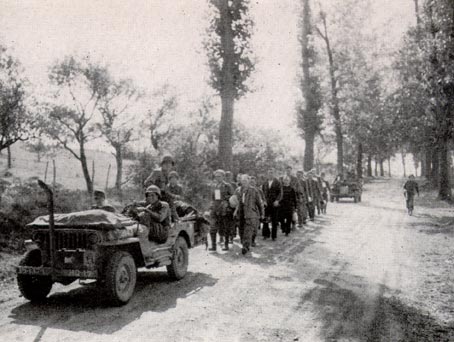| |
In the early part of September,
1944, the XII Corps, under the command of Gen. Manton
Eddy, consisting of the 80th division on the left, 4th
Armored Division in the center, and the 35th Division
on the right, had advanced eastward toward Nancy, and
now faced increasingly stubborn German resistance along
the Mosell River and extending southeast of Nancy to
Luneville along the Meurthe River. This newly established
German line of defense was defended by the German 553rd
Volksgrenadier Division and Ten. Elms’ 15th Panzer
Grenadier Division. The Third Army’s blitz across
France had slowed for lack of gasoline and shortage
of ammunition and supplies. Gen. Patton’s advance
with this Third Army was being limited to short offensive
operations and by German counter-attacks, both actual
and threatened.
Together with the 4th Armored Division, the 35th Division,
on September 11th and 12th had forced a crossing of
the Muerthe River about five miles southeast of Nancy
and on into Dombasle, pursuing the slowly withdrawing
German defenders. North of Nancy, the 80th Division
had crossed the Mosell River and together the 80th and
35th Divisions were preparing to close a noose around
the East of the city.
Meanwhile, a task force under command of our Assistant Division
Commander, Gen. E.B. Sebree, had been formed with the 134th
Infantry Regiment and the 319th Regiment of the 80th Division,
and several 35th supporting units. On September 15th, this
task force entered Nancy, one day after the Germans had slipped
away. An aerial bombardment of Nancy had been ordered for
September 15th, but timely reports to our G-2, Lt. Col. John
Hoyne of the German evacuation during the night, forwarded
to the Air Force Commander, resulted in the bombing attack
being cancelled and Nancy, the sixth largest city in France,
and known as the “Paris of the East” was spared
destruction, and became the headquarters of the Third Army
(established in Stanislas Square) and the chief bridgehead
for the main army supply lines leading into Lorraine. Too
much credit cannot be given to the French intelligence groups
and their commanders such as Major Crinon and Capt. Roget
Senzig, who infiltrated the German lines, cut communication
lines, and brought back invaluable information on enemy plans
and movements, at great risk to themselves.

"Victors and Vanquished"
- after crossing the Moselle
The capture of Nancy on September 15, 1944, marked
the beginning of what the army later officially called
the “Rhineland Campaign” and which battle
was to extend to March 21, 1945. The XV Corps, under
Gen. Wade Haislip, which had been held on the Atlantic
coast to contain the German troops stationed there,
had now arrived with their 79th Infantry Division and
the 2nd French Armored Division, and took over the responsibility
that the 35th Division had been given to protect the
right flank of the Third Army. This permitted the 35th
Division to turn North and sweep up the area to the
East of Nancy, contact the 80th Division, close the
noose around Nancy, and withstand the German counter-attacks
directed at the city.
The XXth Corps, under command of Gen. Walton Walker,
was given the assignment by Gen. Patton to begin an
attack against the fortified city of Metz, using the
2nd, 5th ,90th Division and the 7th Armored Division.
On September 7th they began a bloody operation of assaults
on fortified positions that didn’t end until November
22nd.
 Continue
to Page 2 of 4 Continue
to Page 2 of 4
|